AUDI A8 2011 Owners Manual
Manufacturer: AUDI, Model Year: 2011, Model line: A8, Model: AUDI A8 2011Pages: 302, PDF Size: 76.07 MB
Page 181 of 302
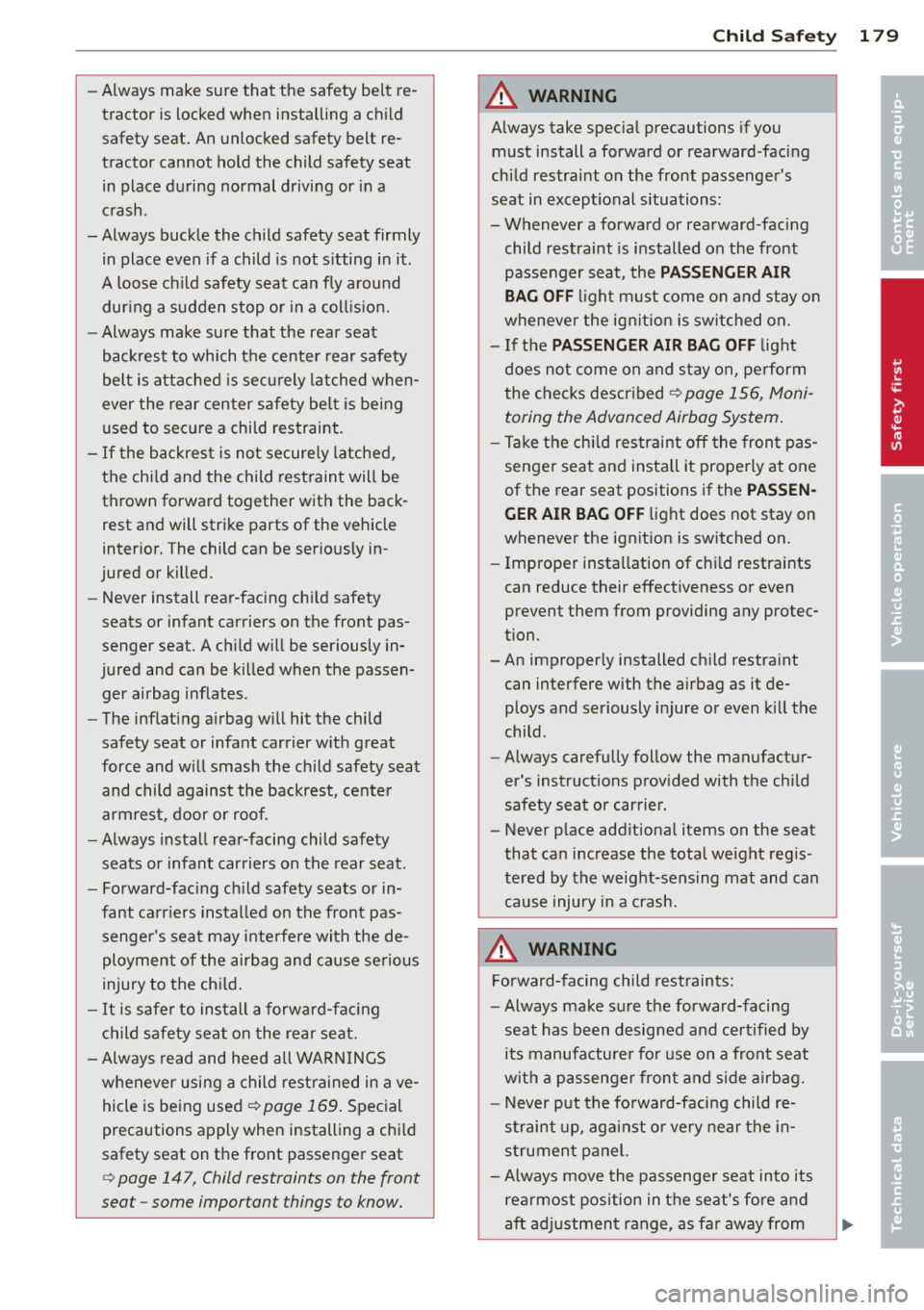
-Always make sure that the safety belt re
tractor is locked when installing a child
safety seat. An unlocked safety belt re
tractor cannot hold the child safety seat
in place during normal driving or in a
crash .
- Always buckle the child safety seat firmly
in place even if a child is not sitting in it.
A loose child safety seat can fly around
during a sudden stop or in a collision.
- Always make sure that the rear seat
backrest to which the center rear safety
belt is attached is securely latched when
ever the rear center safety belt is being
used to secure a child restraint.
- If the backrest is not securely latched,
the child and the child restraint will be
thrown forward together with the back
rest and will strike parts of the vehicle
interior. The child can be seriously in
jured or killed.
- Never install rear-facing child safety
seats or infant carriers on the front pas
senger seat. A child will be seriously in
jured and can be killed when the passen ger airbag inflates .
- The inflating airbag will hit the child
safety seat or infant carrier with great
force and will smash the child safety seat
and child against the backrest, center
armrest, door or roof.
- Always install rear-facing child safety
seats or infant carriers on the rear seat.
- Forward-facing child safety seats or in
fant carriers installed on the front pas
senger's seat may interfere with the de
ployment of the airbag and cause serious
injury to the child.
- It is safer to install a forward-facing
child safety seat on the rear seat.
- Always read and heed all WARNINGS
whenever using a child restrained in ave
hicle is being used
¢page 169. Special
precautions apply when installing a child
safety seat on the front passenger seat
¢ page 147, Child restraints on the front
seat -some important things to know.
Child Safety 1 79
A WARNING
-
Always take special precautions if you
must install a forward or rearward -facing
child restraint on the front passenger's
seat in exceptional situations:
- Whenever a forward or rearward -facing
child restraint is installed on the front
passenger seat, the
PASSENGER AIR
BAG OFF
light must come on and stay on
whenever the ignition is switched on.
- If the
PASSENGER AIR BAG OFF light
does not come on and stay on, perform
the checks described
¢page 156, Moni
toring the Advanced Airbag System.
- Take the child restraint off the front pas
senger seat and install it properly at one
of the rear seat positions if the
PASSEN
GER AIR BAG OFF
light does not stay on
whenever the ignition is switched on.
- Improper installation of child restraints
can reduce their effectiveness or even
prevent them from providing any protec
tion.
- An improperly installed child restraint
can interfere with the airbag as it de
ploys and seriously injure or even kill the
child .
- Always carefully follow the manufactur
er's instructions provided with the child
safety seat or carrier .
- Never place additional items on the seat
that can increase the total weight regis
tered by the weight-sensing mat and can
cause injury in a crash.
A WARNING
Forward-facing child restraints:
- Always make sure the forward-facing
seat has been designed and certified by
its manufacturer for use on a front seat
with a passenger front and side airbag.
- Never put the forward-facing child re
straint up, against or very near the in
strument panel.
- Always move the passenger seat into its
rearmost position in the seat's fore and
aft adjustment range, as far away from •
•
Page 182 of 302
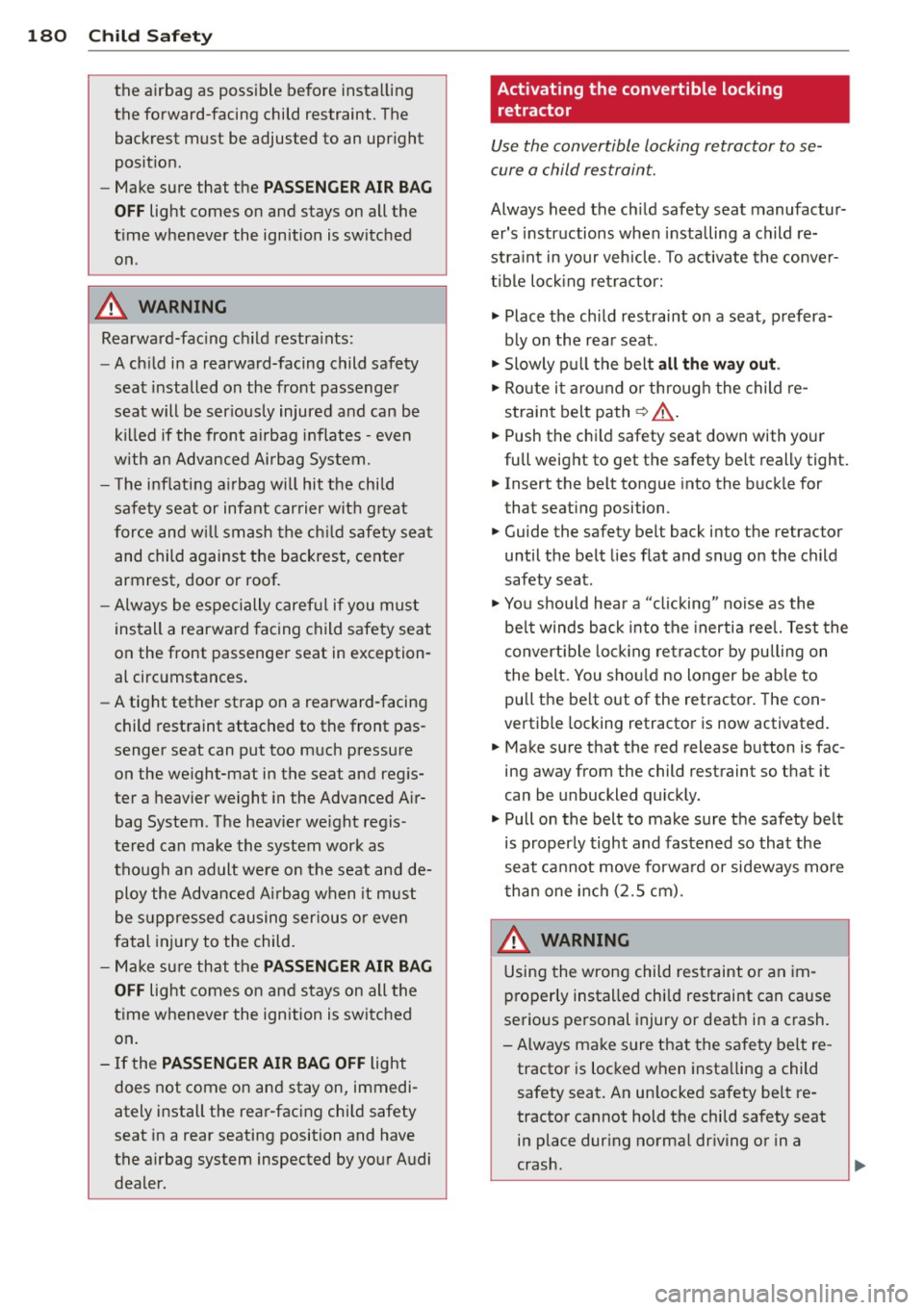
180 Child Safety
the airbag as possible before installing
the forward-facing child restraint. The backrest must be adjusted to an upr ight
posit ion.
- Make sure that the
PAS SENGER AIR BAG
OFF
light comes on and stays on all the
t ime whenever the ignition is switched
on.
A WARNING , _
Rearward-fac ing ch ild restra ints:
- A ch ild in a rearward-facing child safety
seat installed on the front passenge r
seat will be ser iously injured and can be
killed if the front airbag inflates -even
with an Advanced Airbag System.
- T he inflating a irbag will hit the child
safety seat or infant carrier with g reat
force and w ill smash the ch ild safety seat
and child against the backrest, center
armrest, door or roof .
- Always be especially caref ul if you must
install a rearward facing child safety seat
on the front passenge r seat in exception ·
al circumstances .
- A tight tether strap on a rearward-facing
child restraint attached to the front pas
senger seat can put too much pressure
on the weight-mat in the seat and reg is
ter a heavier weight in the Advanced A ir
bag System. The heav ier we ight regis
tered can make the system work as
though an adult were on the seat and de ploy the Advanced Airbag when it must
be s uppressed causing ser ious or even
fatal injury to the child.
- Make sure that the
PASSENGER AIR BA G
OFF
light comes on and stays on all the
time whenever the ignition is switched on.
- If the
PA SSENGER AIR BAG OFF light
does not come on and stay on, immedi
ately install the rea r-facing chi ld safety
seat in a rear seating position and have
the a irbag system inspected by your Audi
dealer.
Act ivating the convertible locking
retractor
Use the convertible locking retractor to se
cure a child restraint.
Always heed the ch ild safety seat manufactur
er's instructions when installing a child re
st ra int in your vehicle. To activate the conve r
t ible lock ing ret ractor:
.,. Place the ch ild restraint on a seat, prefera
bly on the rear seat .
.,. Slowly pu ll the belt
all the wa y out .
.,. Route it around or through the child re
straint belt path
¢ _& .
.,. Push the chi ld safety seat down with yo ur
full weight to get the safety be lt really tight.
.. Insert the belt tongue into the buck le for
that seating position.
.,. Guide the safety belt back into the retractor
until t he belt lies flat and snug on the child
safety seat.
.,. You should hear a "clicking" noise as the
be lt winds back into the inertia ree l. Test the
convert ible lock ing retractor by pulling on
the belt . You shou ld no longer be able to
pull the be lt out of the retractor. The con
vertible locking retractor is now activated .
.. Make sure that the red release button is fac
ing away from the child restraint so that it
can be unbuckled quickly.
.,. Pull on the belt to make sure the safety belt
is properly tight and fastened so that the
seat cannot move forward or sideways mo re
than one inch (2.5 cm).
A WARNING
-
Using the wrong child restraint or an im
p roperly installed chi ld restraint can cause
serious personal injury or death in a crash.
- Always ma ke sure that the safety belt re-
tractor is locked when insta lling a child
safety seat . An un locked safety belt re
tractor cannot hold the child safety seat in place dur ing norma l dr iving or in a
crash.
Page 183 of 302
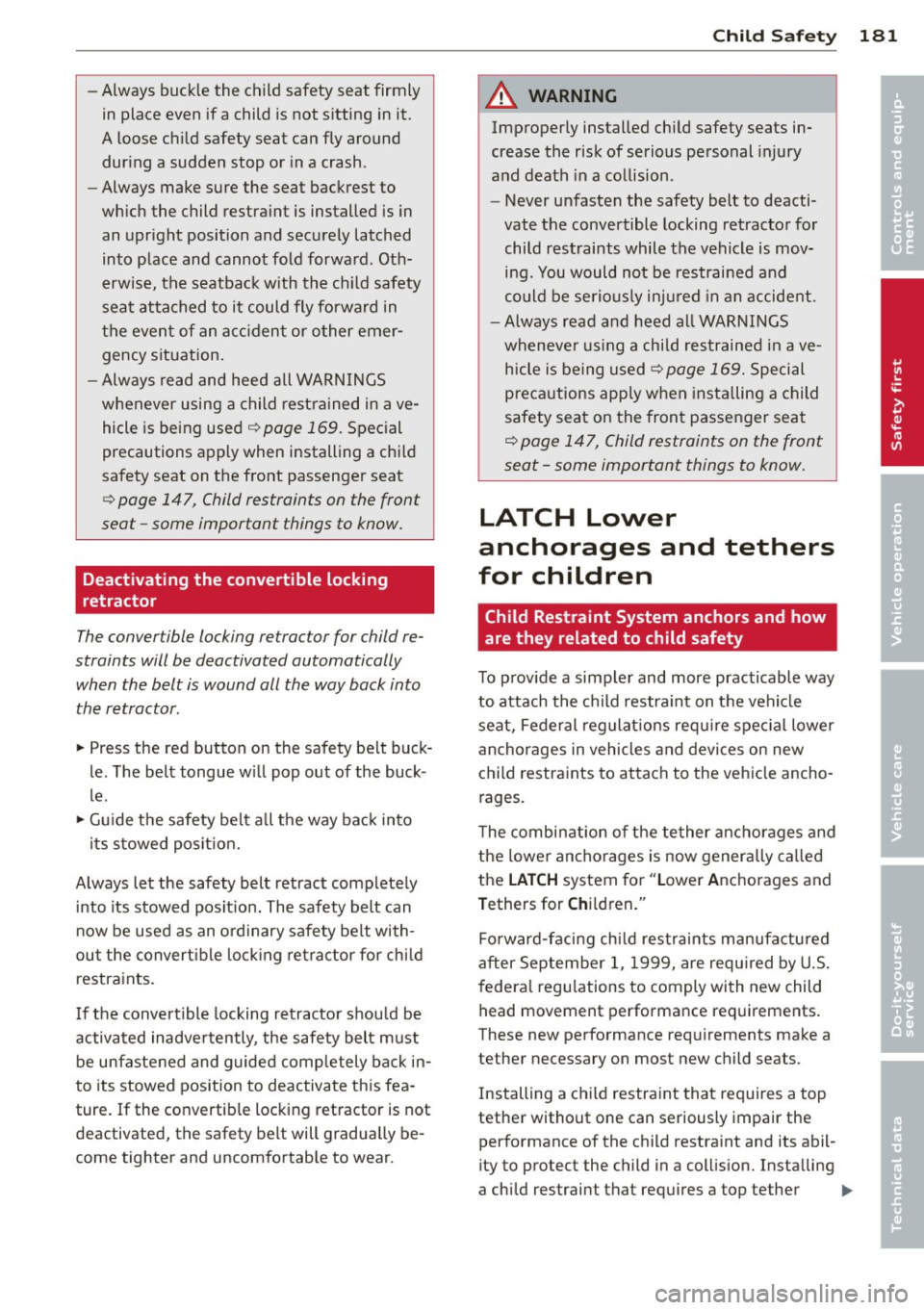
-Always buckle the child safety seat firmly
in place even if a child is not sitting in it.
A loose child safety seat can fly around during a sudden stop or in a crash.
- Always make sure the seat backrest to
which the child restraint is installed is in
an upright position and securely latched
into place and cannot fold forward. Oth
erwise, the seatback with the child safety
seat attached to it could fly forward in
the event of an accident or other emer gency situation.
- Always read and heed all WARNINGS
whenever using a child restrained in ave
hicle is being used
Q page 169. Special
precautions apply when installing a child
safety seat on the front passenger seat
Q page 147, Child restraints on the front
seat -some important things to know.
Deactivating the convertible locking
retractor
The convertible locking retractor for child re
straints will be deactivated automatically when the belt is wound all the way back into
the retractor .
.. Press the red button on the safety belt buck
le . The belt tongue will pop out of the buck
le.
.. Guide the safety belt all the way back into
its stowed position.
Always let the safety belt retract completely into its stowed position. The safety belt can
now be used as an ordinary safety belt with
out the convertible locking retractor for child
restraints.
If the convertible locking retractor should be
activated inadvertently, the safety belt must
be unfastened and guided completely back in
to its stowed position to deactivate this fea
ture. If the convertible locking retractor is not
deactivated, the safety belt will gradually be
come tighter and uncomfortable to wear.
Child Safety 181
A WARNING
Improperly installed child safety seats in
crease the risk of serious personal injury
and death in a collision.
- Never unfasten the safety belt to deacti
vate the convertible locking retractor for
child restraints while the vehicle is mov ing. You would not be restrained and
could be seriously injured in an accident.
- Always read and heed all WARNINGS
whenever using a child restrained in ave
hicle is being used¢
page 169. Special
precautions apply when installing a child
safety seat on the front passenger seat
¢ page 147, Child restraints on the front
seat -some important things to know.
LATCH Lower
anchorages and tethers
for children
Child Restraint System anchors and how
are they related to child safety
To provide a simpler and more practicable way
to attach the child restraint on the vehicle
seat, Federal regulations require special lower
anchorages in vehicles and devices on new
child restraints to attach to the vehicle ancho
rages .
The combination of the tether anchorages and
the lower anchorages is now generally called
the
LATCH system for " Lower Anchorages and
Tethers for Children."
Forward-facing child restraints manufactured
after September 1, 1999, are required by U.S.
federal regulations to comply with new child
head movement performance requirements .
These new performance requirements make a
tether necessary on most new child seats.
Installing a child restraint that requires a top
tether without one can seriously impair the
performance of the child restraint and its abil
ity to protect the child in a collision. Installing
a child restraint that requires a top tether ..,. •
•
Page 184 of 302
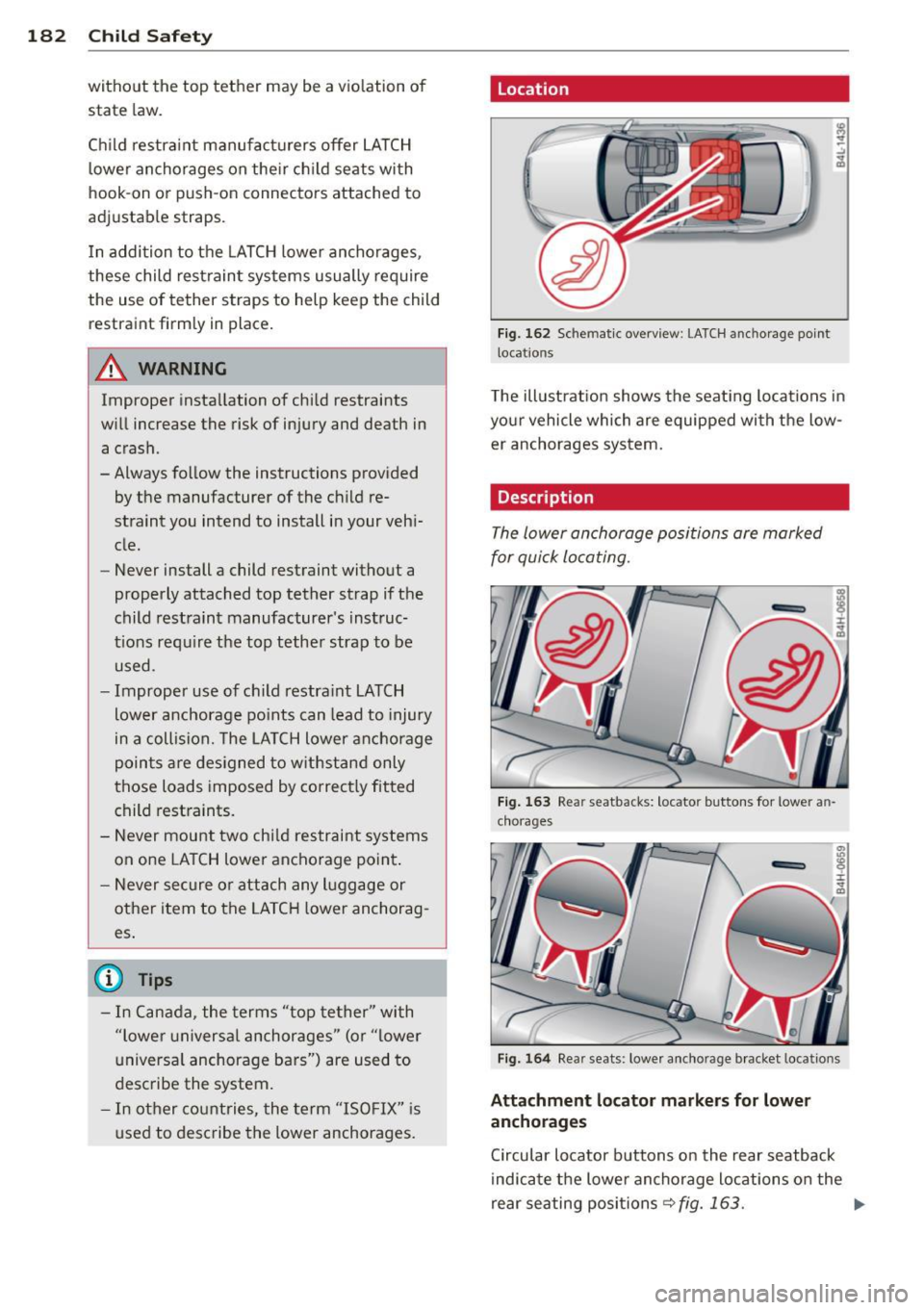
182 Child Safet y
without the top tether may be a vio lation of
state law.
Ch ild restra int manufacturers offer LATCH
lowe r anchorages on the ir ch ild seats with
hook-on or push -on connectors attached to
adj ustab le straps.
I n addition to the LATC H lower anchorages,
these child rest raint systems usually require
the use of tether straps to help keep the child
restraint firmly in place.
.&_ WARNING
Improper insta llation of chi ld restraints
w ill increase the risk of injury and death in
a crash.
- Always fo llow the instructions provided
by the manufacturer of the ch ild re
straint you intend to install in your veh i
cle.
- Never install a child restraint without a
properly attached top tether st rap if the
child restra int manufacturer's inst ruc
t ions req uire the top tether strap to be
used .
- Improper use of child restra int LATCH
lower anchorage po ints can lead to injury
in a collision. The LA TCH lower anchorage
points a re des igned to w ithstand only
those loads imposed by correct ly fitted
child restraints.
- Never mount two ch ild restraint systems
on one LA T CH lower anchorage poin t.
- Never se cure or attach any l ugg age or
other item to the LATC H lower anchorag
es .
(j) Tips
-In Canada, the terms "top tether" with
"lower universa l anchorages" (or " lower
universa l anchorage bars") are used to
describe the system.
- In other co un tries, the term "ISO FIX" is
used to desc ribe the lower anchorages.
Location
F ig. 162 Sc hem at ic ove rv iew : LATCH anch orage po int
l ocat io ns
T he illust rat ion shows the seat ing loca tions in
your vehicle which are equipped wi th the low
er anchorages system.
Description
The lower anchorage positions are marked
for quick locating.
F ig . 1 63 Rear seatb acks: loc ato r but tons for lowe r an
chorages
en
lg
± ...
"' (
F ig . 16 4 Rea r seats : lowe r an cho rage b ra cket lo cat ions
Attachment locator markers for lowe r
anchorages
Circular locator buttons o n the rear seatback
indica te the lowe r an chorage locations on the
rear seating posi tions
~ fig. 163 . ..,.
Page 185 of 302

Lower ancho rag es
The lower anchorage attachment points are
located between the rear seatback and rear
seat c ushion
¢ fig. 164.
Lower anchorages secure the child restraint in
the seat witho ut using the vehicle 's safety
be lts . Anchorages provide a secure and easy
to- use attachment and minimize the possibili
ty of improper chi ld restraint installation.
All ch ild restra ints man ufact ured after Sep
tember 1, 2002, must have lower anchorage
attachments for the
LATCH system.
Remembe r that the lowe r anchorage points
are only intended for i nstallation and attach
ment of child restraints specifical ly certified
for use with
LATCH l ower anchorages . Child
restra ints that are not equipped with the low
er anchorage attachments can still be instal led in compliance with the c hild restra int
manufacturer's instruct ions on using vehicle
safety belts .
_&, WARNING
Improper use of LATCH lower anchorages
can cause serious personal i njury in an ac
cident .
- Always carefully fo llow the ch ild re
straints manufacturer's inst ruct ions for
proper installation of the child restra in t
and proper use of the lower anchorages
or safety belts in your vehicle .
- Never secure o r attach any l uggage or
other items to the
LATCH lower ancho
rages.
- Always read and heed the important in
formation about child restra ints in this
chapter and WARNINGS
¢ page 169,
Child Safety .
Child Safety 183
Guidance fixtures for lower anchorages
Special guidance fixtures increase the conven
ience of the lower anchorages and ore ovoilo
ble from your authorized Audi dealer .
Fig . 1 65 Outer r ear seats : inst alling the gu idanc e fix
t u res
8 ± ... a,
Fig . 1 66 Close-up: fitt ing t he g uida nce fixture over the
l ower ancho rage bracket
T he lower ancho rage attachment poi nts are
located on the rear seats between the seat
back and the seat cushion. Special guidance
fixtures increase the convenience of the lower
anchorages and help protect the seat material
from possible damage when install ing ch ild
restraints.
Installing the guidanc e fixture s
.,. Push down on the seat cushion so that the
lower anchorages are visible .
.,. Ho ld the guidance fixture with the part
number facing downward and push it in the
direction of the arrow onto the anchorage
¢ fig . 166 .
.,. Make su re that each of the two guidance fix
tures per seat snaps into place .
Removing the gu idance fixtures
.,. Remove the ch ild restraint according the
child restraint manufacturer's instructions. .,..
Page 186 of 302
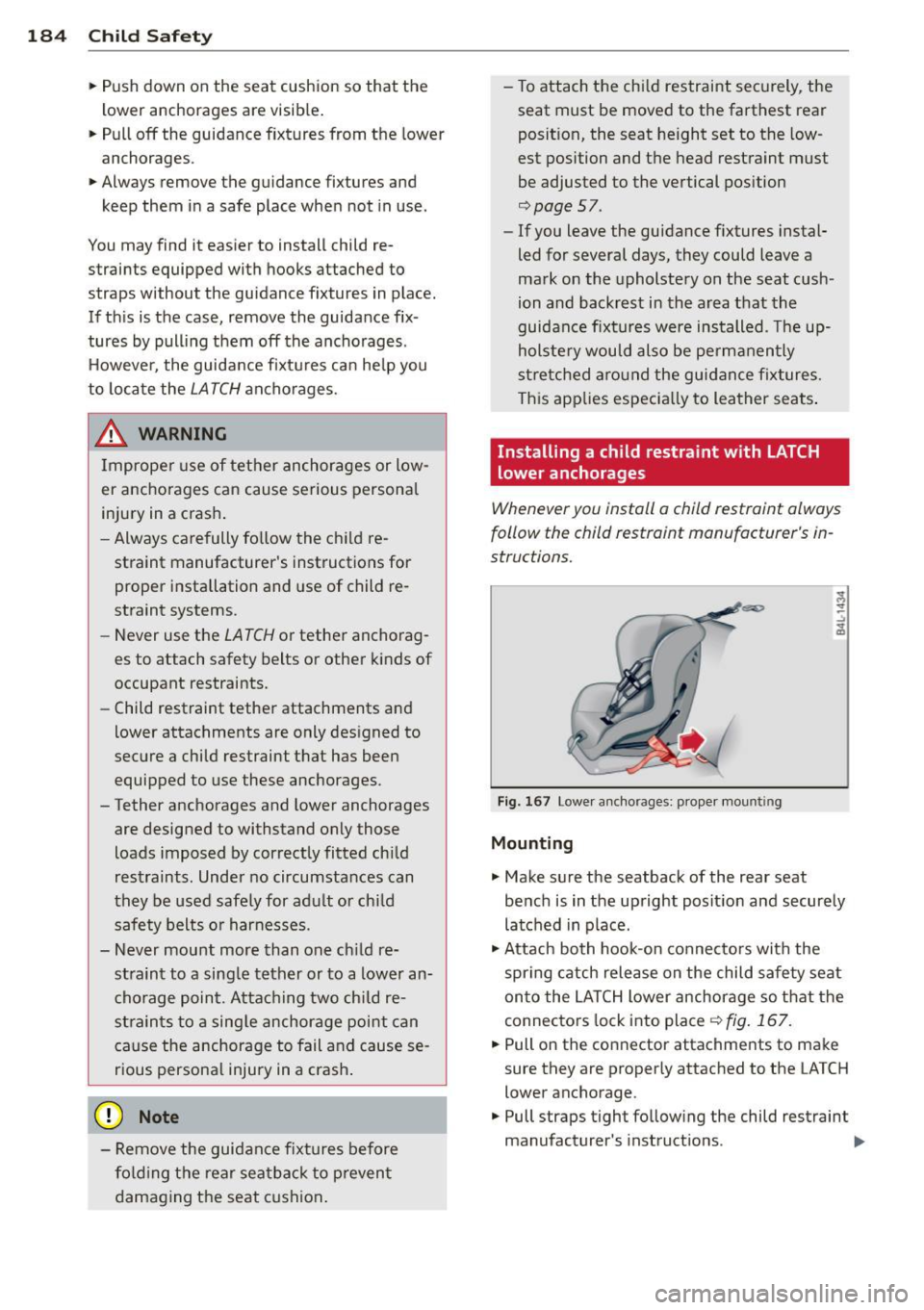
184 Child Safet y
• Push down on the seat cushion so that the
lower anchorages are visib le.
• Pull
off the guidance fixtures from the lower
anchorages.
• Always remove the guidance fixtures and
keep them in a safe place when not in use.
You may find it easier to install child re
straints equipped with hooks attached to
straps without the guidance fixtures in place.
If this is the case, remove the guidance fix
tures by pull ing them
off the anchorages .
H oweve r, the guidance fixtu res can he lp you
to locate the
LATCH ancho rages.
.&_ WARNING
Imprope r use of tether anchorages or low
er anchorages ca n cause serious persona l
injury in a crash .
- Always carefully fo llow the child re
straint manufacturer 's instructions for
proper insta llation and use of child re
straint systems .
- Never use the
LATCH or tethe r anchorag
es to attach safety belts or other kinds of
occupant restraints.
- Child restraint tether attachments and
lower attachments are only des igned to
secure a child restraint t hat has been
equipped to use these anchorages.
- Tether anchorages and lower anchorages
are designed to withstand only those
loads imposed by correctly fitted ch ild
restraints. Under no circumsta nces can
they be used safely for adu lt or chi ld
safety belts o r harnesses.
- Never mou nt more than one ch ild re
stra in t to a sing le tether or to a low er an
c ho rage poin t. Attac hing two chi ld re
st rain ts to a sing le anchor age poi nt can
cause the anchorage to fail and cause se
rious persona l injury in a crash .
0 Note
- Remove the guidan ce fixt ures before
fo ld ing t he rear sea tba ck t o preven t
dam aging the seat c ushion . -
To attach the ch ild restraint sec urely, the
seat must be moved to the farthest rear
posit ion, the seat height set to the low
est position and t he head restraint must
be adjusted to the vertical position
¢page 57.
-If you leave the guidance f ixtures instal
led for several days , they could leave a
mark on the upholstery on the seat cush
ion and back rest in the area that the
guidance fixtures were installed . T he up
holste ry wou ld al so be pe rmanen tly
stretched aro und the gui dance fix tures.
Th is ap plies especia lly to lea ther seats .
Installing a child restraint with LATCH
lower anchorages
Whenever you install a child restraint always
follow the child restraint manufacturer's in
structions.
F ig. 167 Lowe r a nchorages: proper mount ing
Mounting
• Make sure the seatback of the rear seat
bench is in the upright posit ion and securely
latched in place .
• Attach bo th hook-on connectors with the
spring catch release on the child safety seat
on to the LATCH lower anchorage so that the
connecto rs lock into place
¢ fig. 167.
•Pullon the connector attachments to make
sure they are proper ly attached to the LATCH
lower anchorage .
• Pull straps tight following the child restraint
manufacturer's instruct io ns. .,,.
Page 187 of 302
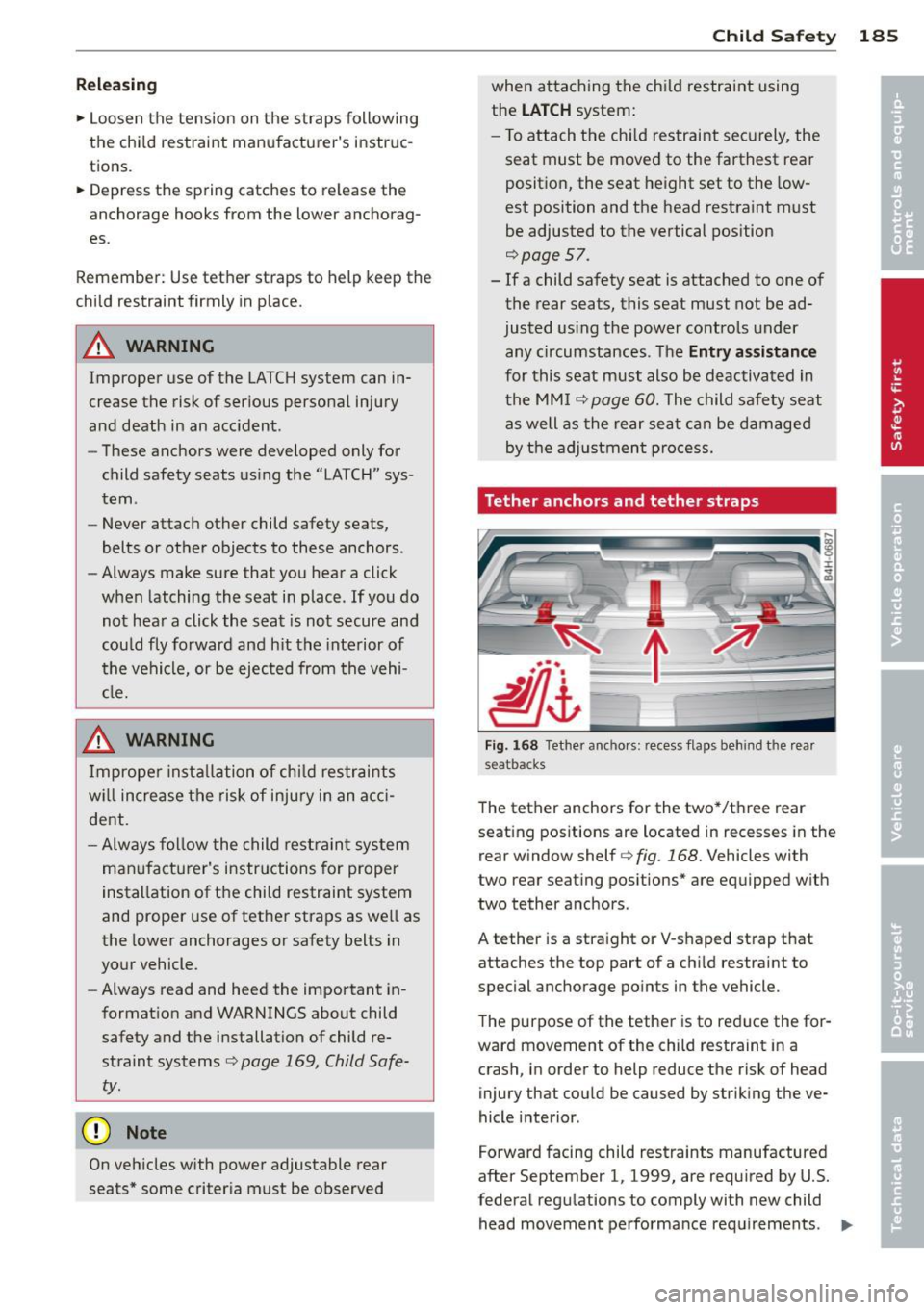
Releasin g
• Loosen the tension on the straps following
the chi ld restraint manufacturer's instruc
tions .
• Depress the spring catches to release the
anchorage hooks from the lower anchorag
es.
Remember: Use tether straps to help keep the
child restraint firmly in p lace.
A WARNING
Improper use of the LATCH system can in
crease the risk of serious personal injury
and death in an acc ident.
- These anchors were developed only for
child safety seats us ing the "LATCH" sys
tem .
- Never attach other child safety seats,
belts or other objects to these anchors .
- Always make sure that you hear a click
when latching the seat in place. If you do
not hear a click the seat is not secure and
cou ld fly forward and h it the interior of
the vehicle, or be ejected from the vehi cl e.
A WARNING
Imprope r insta llation of chi ld restr aint s
w ill increase the risk of inju ry in an acc i
dent.
- Always fol low the child rest raint sys tem
man ufacturer's instr uctions for proper
installation of the child restraint system
and proper use of tethe r straps as we ll as
the lower anchorages or safety belts in
your vehicle.
- Always read and heed the important in
format ion and WARNINGS about child
safety and the installation of child re
straint systems
q page 169, Child Safe
ty .
(D Note
On veh icles with power adjustable rear
seats* some criter ia must be observed
Child S afety 185
when attaching the ch ild restraint using
the
LATCH system:
- T o attach the chi ld restraint securely, the
seat must be moved to the farthest rear
position, the seat height set to the low
est position and the head restraint must
be adjusted to the vertical pos ition
9page57.
- If a child safety seat is attached to one of
the rear seats, this seat must not be ad
justed using the power controls under
any c ircumstances. The
Entry assistanc e
for this seat must also be deactivated in
the MM I
9 page 60. The child safe ty seat
as well as the rear seat can be damage d
by t he a dju stmen t process.
Tether anchors and tether straps
Fig. 168 Tet her anc hor s: recess flaps beh ind t he rea r
seatbacks
The tether anchors for the two * /t hree rear
seat ing pos itions are located in recesses in the
rear window shelf
q fig . 168. Vehicles with
two rear seating positions* are equipped w ith
two tether anchors .
A tether is a stra ight or V-s haped strap that
attaches the top part of a ch ild restraint to
special anchorage points in the vehicle.
The purpose of the tether is to reduce the for
ward movement of the child restraint in a
crash , in order to help reduce the risk of head
injury that could be caused by striking the ve
hicle interior .
Forward facing child restraints manufactured
after September 1, 1999, are requ ired by U.S.
federal regulations to comply with new child head movement performa nce requ irements .
II-
Page 188 of 302
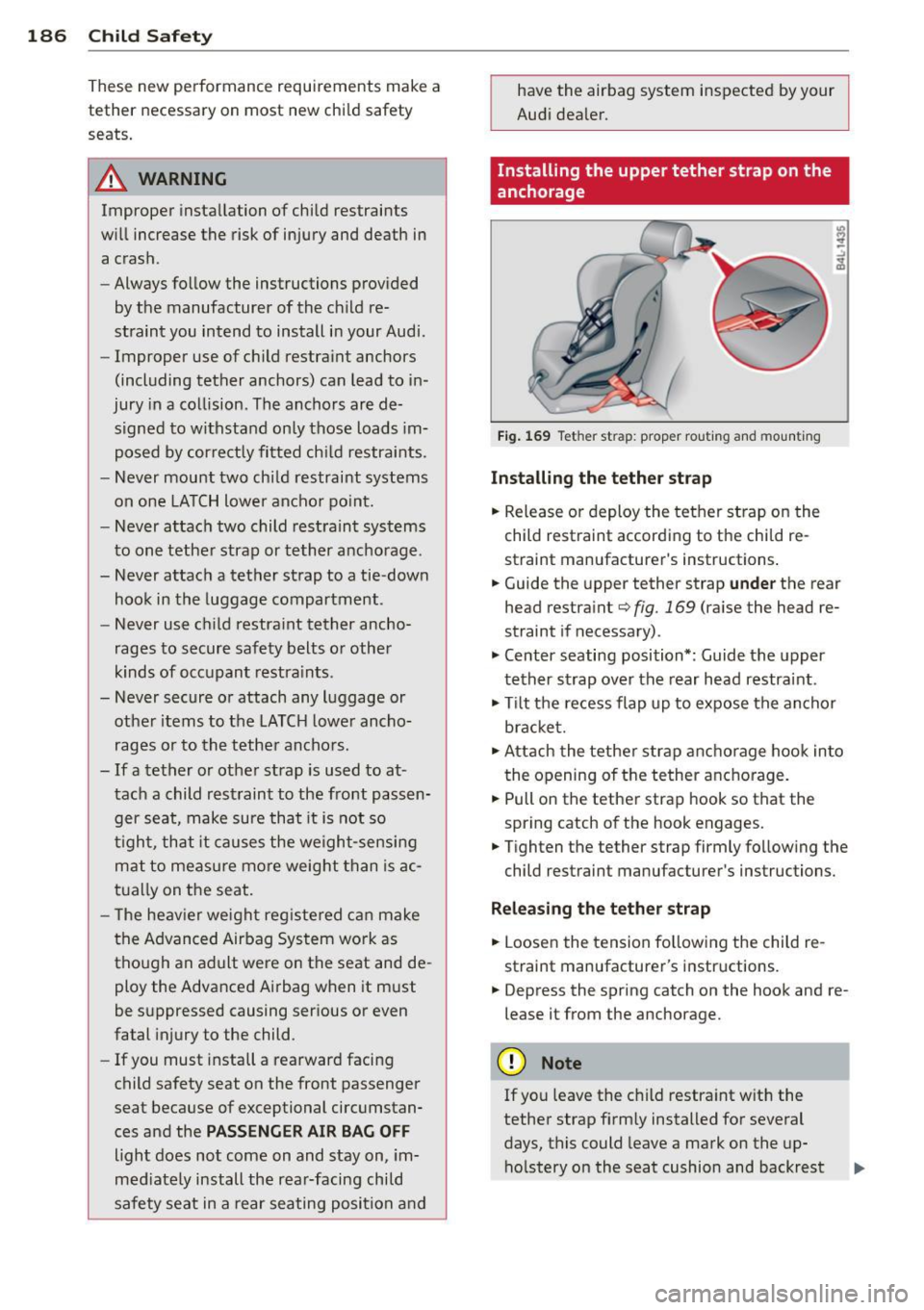
186 Child Safet y
These new performance requirements make a
tether necessary on most new child safety
seats.
.&_ WARNING
Improper insta llation of child restraints
wi ll increase the risk of injury and death in
a crash.
- Always follow the instructions prov ided
by the manufacturer of the ch ild re
straint you intend to install in your Audi .
- Improper use of child restra int anchors
(including tether anchors) can lead to in
jury in a collision. The anchors are de
signed to withstand on ly those loads im
posed by cor rect ly fitted ch ild restraints.
- Never mou nt two ch ild restraint systems
on one LA T CH lower ancho r po int.
- Never attach two child restraint systems
to one tethe r strap or tether anchorage.
- Never attach a tether strap to a tie-down hook in the luggage compartment.
- Never use c hild restraint tether ancho
rages to secure safety belts o r other
k inds of occ upant restra ints.
- Never secure or attach any luggage or other items to the LATC H lowe r ancho
rages or to the tethe r anchors.
- If a tether or othe r strap is used to at
tac h a child rest raint to the front passen
ger seat, make sure that it is not so
t ight, that it causes the we ight-sensi ng
mat to measure more weight than is ac
t u a lly on t he seat.
- T he heav ier we ight reg iste red can make
t he Advanced Airbag Sys tem work as
though an adult were on the seat and de
ploy the Advanced Airbag when it must
be s uppressed causing serious or even
fatal injury to the child.
- If you must install a rearward facing
child safety seat on the front passenger
seat beca use of exceptional circ umstan
ces and the
PASSENGER AIR BAG OFF
light does no t come on and stay on, im
med iately install the rea r-facing child
safety seat in a rear seating position a nd
-
have the airbag system inspected by your
Aud i dea ler.
Installing the upper tether strap on the
anchorage
F ig . 1 69 Tether strap: proper ro uting and mount ing
Installing the tether strap
"' Release or deploy the tether st rap on the
child restraint according to the child re
straint manufacturer's instructions .
"' Guide the upper tether strap
under the rear
head restra int¢
fig. 169 (ra ise the head re
straint if necessary) .
"' Center seating position*: Guide the upper
tether strap over the rear head restra int.
"' Tilt the recess flap up to expose the an chor
b racket.
"' Att ach the tether strap ancho rage hook in to
the opening of the tethe r ancho rage.
"' Pull on the tether strap hook so that the
spring catch o f the hook engages.
"' Tighten the tether strap firmly fo llow ing the
child restraint manufacturer's instructions.
Releasing the tether strap
"'Loosen the tension fo llow ing the child re
straint manufacture r's in str uctions.
"' Depress the spring catch on the hook and re
lease it from the anchorage.
(D Note
If yo u leave the c hild restra int w it h the
tether strap firm ly installed for seve ral
days, this could leave a mark on the up
ho lstery on the seat cushion and backrest
Page 189 of 302
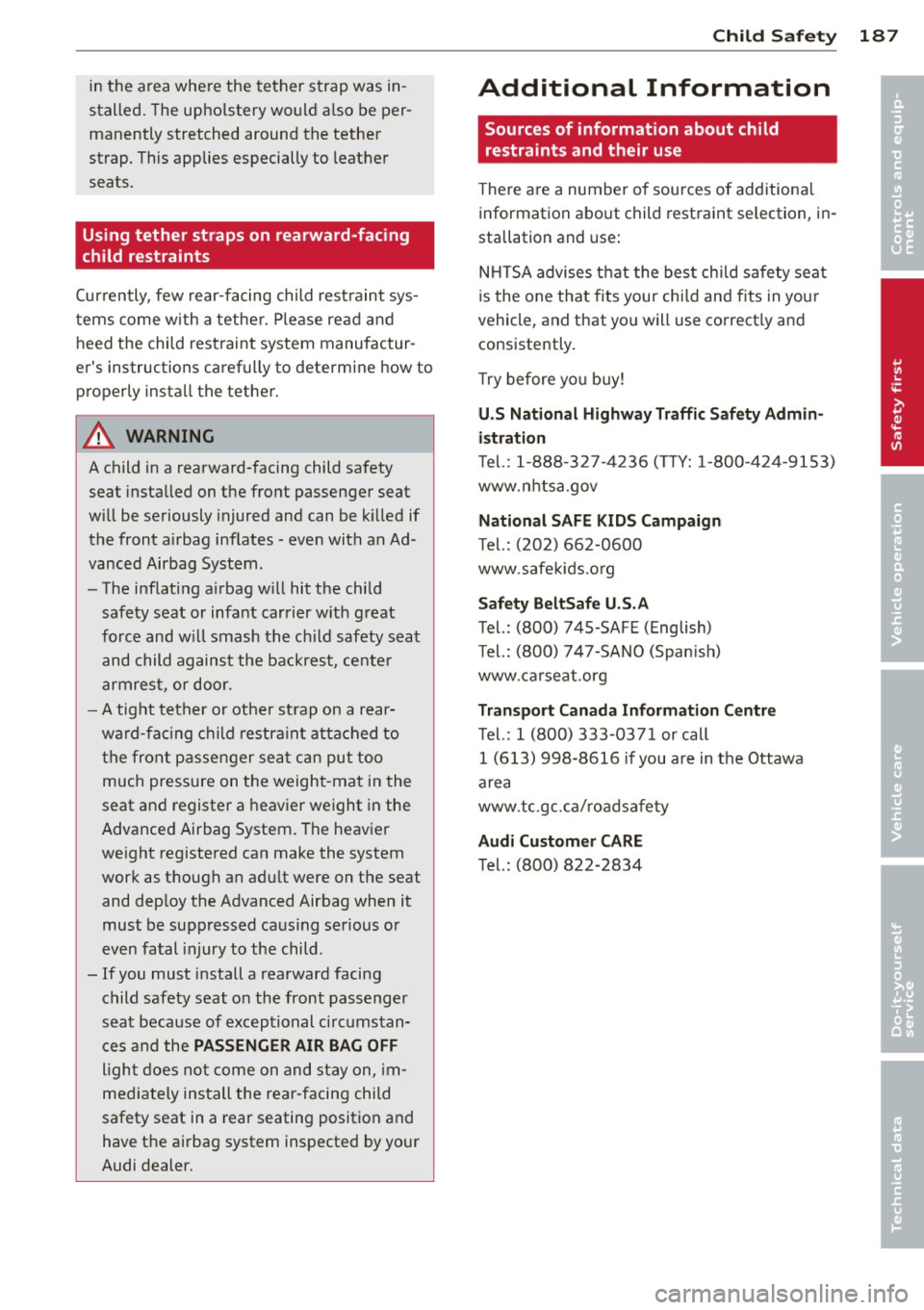
in the area where the tether strap was in
stalled. The upholstery wo uld a lso be per
manently stretched around the tether
strap. This applies especially to leather
seats.
Using tether straps on rearward-facing
child restraints
Curren tly , few rear-facing child res traint sys
tems come with a tethe r. P lease re ad an d
heed the child res traint system manufactur
er's instructions carefully to determine how to
properly insta ll the tethe r.
A WARNING
A child in a rearward-facing child safety
seat installed on the front passenger seat
w ill be seriously injured and can be k illed if
the front a irbag inflates -even with an Ad
vanced Airbag System.
- The inflating a irbag w ill hit the child
safety seat or infant carrier w ith g reat
force and w ill smash the ch ild safety seat
and child against the backrest, ce nte r
armrest, or door.
- A tight tether or other st rap on a rear
wa rd-fa cing child restra int attached to
the fro nt p assenger se at can put too
much pressure on the weight -ma t in the
seat and register a heavier we ight in the
Advanced Airbag System. The heavier
we ight registered can make the system
work as though an ad ult were on the seat
and dep loy the Advanced Airbag when it
must be suppressed caus ing se rious or
ev en fatal injury to the child.
- If you must install a rearward facing child safety seat o n the front passenger
seat because of exceptional circumstan ces a nd the
PASSENGER AIR BAG OFF
ligh t d oes no t come on and stay on, im
med iately install the rear-facing child
safety seat in a rear seating position and
have t he a irbag system inspected by you r
Audi dealer.
Child Sa fet y 187
Additional Information
Sources of information about child
restraints and their use
There are a number o f sources of additiona l
information abo ut child restraint se lection, in
stallation and use :
N HT SA advises t hat the bes t ch ild safety seat
is the one that fi ts your chi ld and fits in your
vehicle, and that yo u will use correct ly and
consistently.
T ry before yo u buy!
U.S National Highway Traffic Safety Admin
istration
Tel.: 1 -888 -3 27-42 36 (TIY: 1-800-4 24-9153)
www. n hts a .gov
National SAFE KIDS Campaign
Tel.: (202) 66 2-0600
www.safe kids.o rg
Safety BeltSafe U .S .A
Tel.: (800) 7 45-SAFE (English)
Te l.: (800) 7 47-SANO (Span ish)
www.carseat .org
Transpo rt Canada Information Centre
Tel.: 1 (800) 333-037 1 or call
1 (613) 998-8616 if you are in the Ottawa
area
www.tc.gc. ca/ ro ad safe ty
Audi Cu stomer CARE
T el.: (800) 82 2-2834 •
•
Page 190 of 302
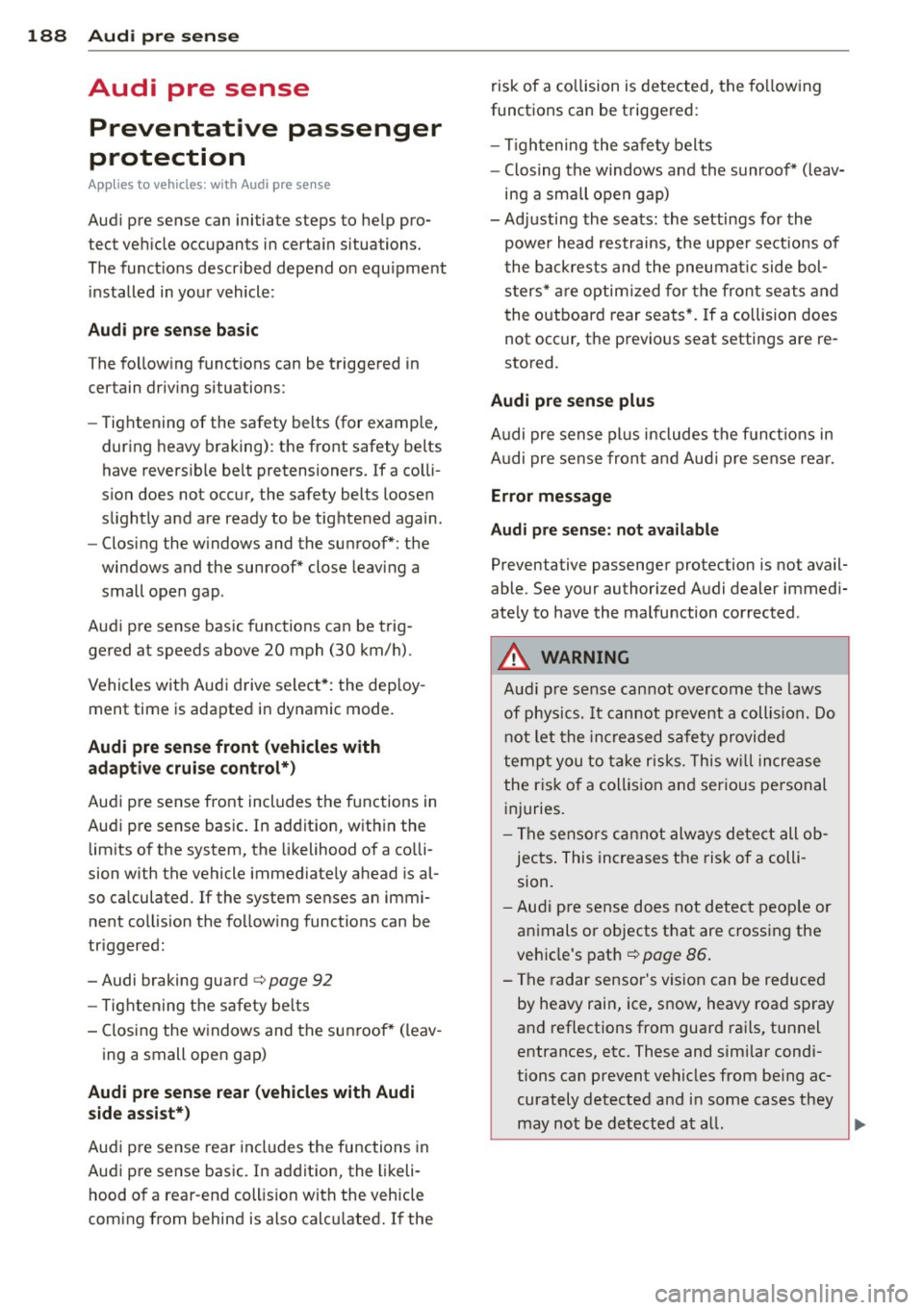
188 Audi pre sense
Audi pre sense
Preventative passenger
protection
A pp lies to veh icles: with Audi pre se nse
Aud i pre sense can ini tia te steps to help pro
t ect veh icle occupants in certain situa tions.
The funct ions described depend on equ ipment
installed in your vehicle:
Audi pre sense basic
The following functions can be triggered in
certain driv ing situations :
- Tightening of the safety belts (for examp le,
during heavy braking) : the front safety belts
have reversible belt pretensioners. If a colli
sion does not occur, the safety belts loosen
s lightly and are ready to be tightened again .
- Closing the w indows and the sunroof* : the
windows and the sunroof* close leaving a
small open gap .
Audi pre sense basic functions can be trig
gered at speeds above 20 mph (30 km/h).
Vehicles with Aud i drive select*: the dep loy
ment time is adapted in dynamic mode.
Audi pre sense front (vehicles with
adaptive cruise control*)
Audi pre sense front includes the functions in
Audi pre sense basic. In addition, within the
limits of the system, the likelihood of a colli
sion with the vehicle immediately ahead is al
so ca lculated . If the system senses an immi
nent collision the follow ing functions can be
tr iggered :
-Audi braking guard
c::> page 92
- Tightening the safety be lts
- Closing the windows and the sunroof* (leav -
ing a small open gap)
Audi pre sense rear (vehicles with Audi
side assist*)
Audi p re sense rear includes the functions in
Audi pre sense basic. In addition, the likeli
hood of a rear -end collis ion with the vehicle
coming from behind is also calc ulated.
If the risk
of a co llision is detected, the following
functions can be triggered :
- Tig htening the safety belts
- Closing the windows and the sunroof* (leav-
ing a small open gap)
- Adjusting the seats : the settings for the
power head restrains, the upper sections of
t he backrests and the pneumatic side bol
s ters* are optim ized for the front seats and
the outboard rea r seats*. If a collision does
not occur, the previo us seat settings are re
stored.
Audi pre sense plus
Audi pre sense plus includes the funct ions in
A udi pre sense front and Audi pre sense rea r.
Error message
Audi pre sense: not available
Preventative passenger protection is not avail
able. See your authorized Audi dealer immedi
ately to have the malfunction corrected .
A WARNING
-Audi pre sense cannot overcome the laws
of physics.
It cannot prevent a collision. Do
not let the increased safety provided
tempt you to take risks. This will increase
the r isk o f a coll is ion and serio us personal
injuries.
- The sensors cannot always detect all ob
jects . This increases the risk of a colli
sion.
- Aud i p re sense does not detect peop le or
animals or objects that are crossing the
vehicle's path
c::> page 86.
-The radar sensor's vis ion can be reduced
by heavy rain, ice, snow, heavy road spray
and reflections from guard rails, tunnel
entrances, etc. These and similar condi
tions can prevent vehicles from be ing ac
curately detected and in some cases they
may not be detected at all.
Ill>